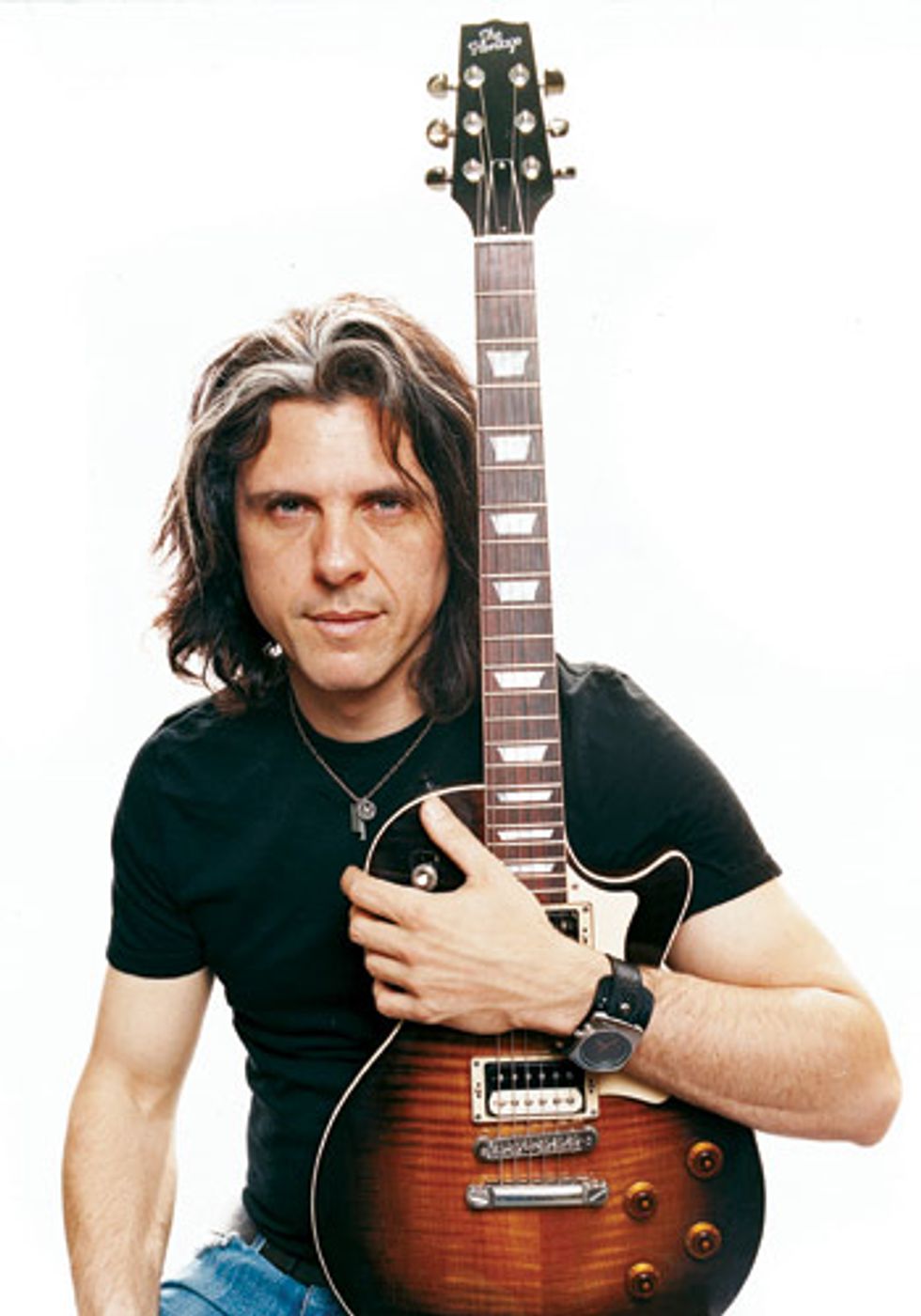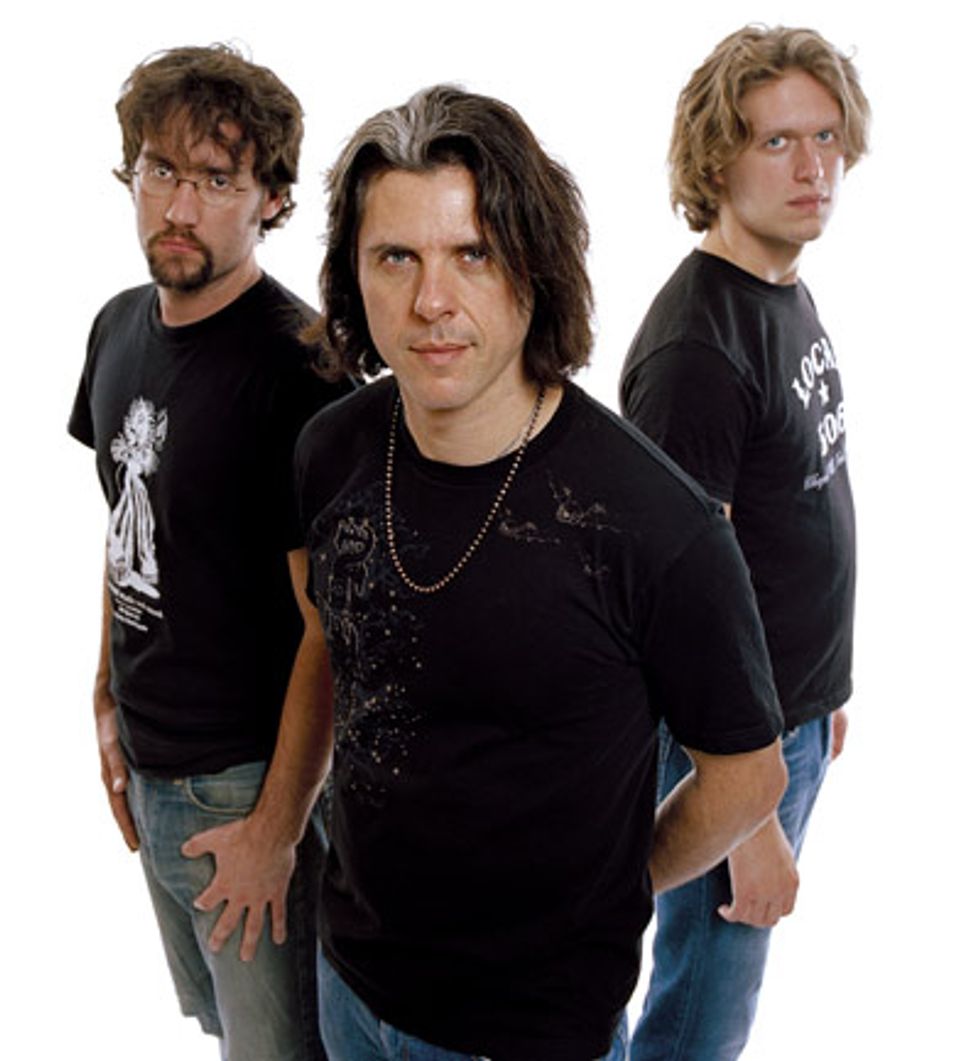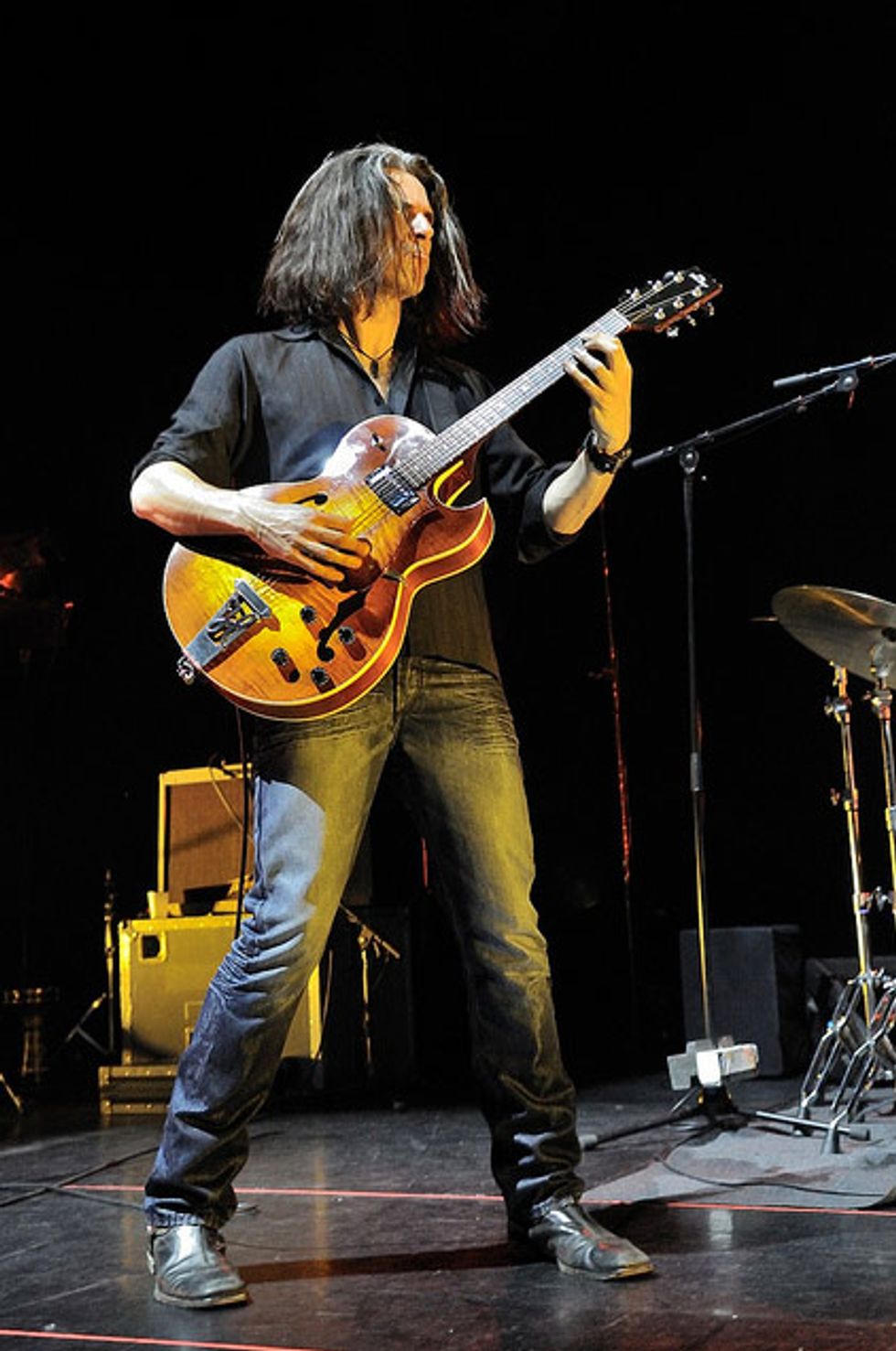Premier Guitar catches up with Skolnick to discuss chasing the perfect guitar tone, influences, and how a Metallica tune helped him to move past his jazz and metal repertoire.
 Photo: Jimmy Hubbard |
The material covered on the album covers a lot of ground, both stylistically and compositionally. On the title track, Skolnick combines delicate chords and arpeggios with a thumping rock backbeat aptly supplied by bassist Nathan Peck and drummer Matt Zebroski. Both Peck and Zebroski have been with Skolnick for nearly a decade, and the interplay between them borders on telepathic. Throughout the album you hear strains of Jeff Beck, John Coltrane, and Jimmy Page—all three are cited as influences in the liner notes—but presented in a way that is entirely improvisational and in some ways, very free-form.
Fresh off a showcase at SXSW, Premier Guitar caught up with Skolnick to discuss chasing the perfect guitar tone, influences, and how a Metallica tune helped him to move past his jazz and metal repertoire.
| Alex Skolnick Lesson Click here to see our exclusive lesson with Alex Skonlick, including example audio and a lick from Veritas. |
I wanted it to be the music I liked—music I put on first thing in the morning. It’s everything from Keith Jarrett to Bill Frisell to e.s.t. to Bach’s Two Part Inventions. I like music that is energizing, inspiring and very clear. There is something about those types of albums that is just very warm, intimate and direct.
When you say “energizing,” you don’t necessarily mean loud and fast, right?
Definitely not. I have this recording of Bach’s Inventions played by a classical pianist named András Schiff. That to me is very energizing. I am not sure why that is, but you can definitely put it on to relax at home. Maybe stimulating is a better word. There are different types of music for different purposes. Speed metal serves a different purpose but I wouldn’t put that on first thing in the morning.
So Veritas is essentially an interpretation of an “Alex Skolnick Morning Mixtape?”
That’s a good way to put it. I wouldn’t say that about the entire album, but a majority of it, yeah.
How did you capture your guitar tone in the studio?
Spin Music Studios, where we recorded this album, is really good. We recorded our first two records in a much smaller studio, where there was a lot more bleeding, making it much more difficult in regards to separation.
My main sound came from my Budda V40 Series II Superdrive, but we worked in a Fender Vibrolux ,my one classic amp, there was well. We used a combination of different guitar mics on both amps, as well as some room mics. We found combinations that would work for each song. A song like “Veritas,” which is very atmospheric and ambient, requires a very different sound than “99/09,” which requires a very dry, crisp and punchy sound.
Are you hands-on when it comes to producing and engineering?
I don’t think I would be a good engineer myself, because I’m not quite as technically minded, but I definitely understand what I like as far as sound. Our engineer, Nick Chiboukas, is perfect. Nick was in a rock band called Collison that actually had a hit on MTV in the ’80s—so he is somebody that understands the musician point of view—but is also very “left-brained.” We would describe the sounds we wanted and he was really good at helping us chase them.
Were these tunes tested out on the road or developed in the studio?
Most of the tunes were put together over the course of a few months. Interestingly, I had written some of them while in Europe doing a Testament tour with Megadeth and Judas Priest. There was a lot of down time on that tour and a lot of mornings spent sitting in the lounge of the bus while everyone else slept. Very often I was overlooking mountains, because a lot of the arena-sized venues in Europe are in remote locations. It was beautiful. At night I would be playing this loud, very aggressive music but then have very peaceful mornings, and I think those mornings really influenced the music for this record. When I would get back to playing with my trio, we would occasionally work in one of these songs, but the vast majority of them were worked out in rehearsals.
You have been playing with your trio for a while. How did you three originally come together?
It started with the drummer, Matt Zebroski, and me just doing it for fun. The experience of this trio coming together has been a metaphor for a lot of things that I have done since—not planned. Matt and I just happened to find each other and moved to New York at the same time to attend The New School, where we studied jazz. Even with our ten-year age difference, we seemed to have more in common than most of the other guys at the school, and we weren’t limited in musical taste. Both of us wanted to have fun with music and play music that contained the jazz aesthetic we were surrounded by, but with no limitations. Our idea was just to play the occasional gig around New York. There are a lot of “low-maintenance” musical projects in New York where you get together just for the purpose of playing. You aren’t thinking about the music business and you aren’t thinking about long-term plans. You just play. It became the best improvisational musical experience I had ever had and the reaction was great. At a certain point it made sense to just pursue it and see where it went.

The Alex Skolnick Trio: Bassist Nathan Peck, Skolnick, and drummer Matt Zebroski. Photo: Jimmy Hubbard.
How did Nathan Peck join the group?
We had a couple different bass players we worked with before Nathan joined us. Our first recording, Goodbye to Romance: Standards for a New Generation, had a different bass player that we met in school. He moved on to play in an indie rock band, even though he was a great upright player. Nathan moved to New York in the mid ’00s and sat in with us a few times. When our first bass player left, we were in a jam since we had a bunch of gigs lined up. We tried a few different guys from the NY jazz scene but as soon as Nate was available, he started playing with us and it just fit like a glove.
On Veritas, the bass is really featured as a melodic instrument. Was that the idea from the beginning?
As I was getting the material together, I started writing specifically for bowed bass and warned Nathan, “You are playing melodies on this record. Get out your bow.” On our first album, I was really trying to make a classic jazz guitar trio album. It was my first attempt at something like that and many people thought I was crazy. Out of respect as much as anything, I wanted to keep it traditional. Certainly some rules were broken in that I was arranging heavy metal songs—plus there are a couple of moments on the first album with distortion—but other than that it was a very traditional album. I think with each subsequent recording of the trio, we wanted to experiment more. We proved we could do the traditional jazz thing and now we had to explore what we had to offer. I think just opening up to these different ideas— such as the bass playing the melody or playing it along with the guitar— makes it more interesting. We even did a couple things like that with the drums. One example was where the drums play a solo in the middle of the song, instead of the end, which is unusual. I started to look for different ways to be expressive compositionally and I think the upright bass is a big mystery for rock fans. Rock listeners don’t really know much about it. I didn’t really know much about it.
It is such a physical instrument.
Yeah, absolutely. It’s this big, intimidating thing. I love the sonic quality of the upright bass since there are so many possibilities, whether it’s plucked or bowed. I like sharing that with people who wouldn’t normally think that the upright bass is such a cool instrument.
Did you use your Heritage guitar for most of the record?
Yeah, I mostly used my Heritage 575, which is a hollowbody guitar. Though my signature Heritage is a solidbody guitar, which is like having a signature Les Paul made in the original factory. It appears on a couple songs where I used it more for texture. I also used my Yamaha LJX26C acoustic, which is a great guitar. I used that guitar to spice up the Indian-flavored tune, “Bollywood Jam.”
The intro to “Bollywood Jam” has some dirt on it. Did that come from the amp?
That was all out of the Budda Budda V40 Series II Superdrive. Even though it’s the first song on the record, it was the last song we recorded. By that time we already had our “template” tone, which was much cleaner. For that tune, we wanted to go nuts and see what happened—just crank up the amps and jam. The song really didn’t have much of a form at first since it really was just a jam. There are some percussion overdubs and Nate played some piano. We definitely took some liberties as far as overdubbing, and in that sense it ties into the experimenting and getting away from the traditional jazz thing. I would say the majority of the album is the three of us playing live in the studio.
Are there certain albums or musicians that inspire you when it comes to creating a “trio” sound?
As much as I love Bill Frisell’s jazz playing, his Americana albums are my favorite. Albums like Nashville, Disfarmer, and Ghost Town are precious, but you couldn’t do that entirely live. For a rock reference, take a look at ZZ Top. It’s just three guys, but there are more than just three tracks and more than the three instruments on those those classic records. Once we spiced things up with the Yamaha, things really took on this whole world music tone.
There is a heavy Scofield-vibe on “99/09.” Was he a big influence?
It’s deliberately Scofield-inspired. He is one of the most sophisticated jazz guitar players of all time, though there’s a funk element on a lot of his music. I have this great Chet Baker album called You Can’t Go Home Again, and it has Scofield, Michael Brecker and Richie Beirach on keyboards, a guy I studied with at The New School. Parts of it are just straight-up funk and I wanted to have a track where I get to play and be influenced by that.

Skolnick onstage with the Trio for a show with Rodrigo y Gabriela in Paris in April 2010. Photo: Franck Simon.
Do you feel that you are influenced as much by your contemporaries as you are more historical players?
Oh yeah. That’s what happens as you get older. You meet people your age or even younger that have developed these skills and taken in their own influences—and in some cases, your influence. That is something I never imagined. Rodrigo y Gabriela, this instrumental supergroup I first saw on Jimmy Kimmel, credits the stuff I did with Testament as an influence on what they do. I had no idea, but that was a huge honor and acknowledgment that I wasn’t so crazy—it really felt so out of left field to be into jazz but be in a speed metal band. Seeing the result of that and the fact that it could influence people like Rodrigo y Gabriela is very gratifying. The stuff they have done has also influenced me.
Is there a specific track on the new album that demonstrates their influence?
“Alone in Brooklyn” has this buildup to a very “rock” section on the nylon-stringed guitar. That is probably something I wouldn’t have thought of if it weren’t for them. I’m not saying I wouldn’t of thought of doing a nylon-stringed guitar piece and having it be ambient, but where it goes is something I thought, “Well, Rod and Gab can do stuff like that, why not me?”
A fair amount of your past albums included jazz arrangements of classic rock and metal tunes. On this album, you included Metallica’s “Fade to Black.” Do you feel you are moving on from that material?
I think we are moving on. That is one of the reasons why I chose that tune. I think the title was appropriate, but also I wanted to do a Metallica tune for a while. It seemed a shame not to do one and it was only a matter of time before someone else did. We are sort of in a period where I could just imagine a younger, competent jazz musician taking on a Metallica tune like “Enter Sandman,” or the song from Mission Impossible. “Fade to Black” is a tune that is unequivocally great. No matter of what period of Metallica you like, it’s a great song that helped make them a supergroup.
What elements do you look for in a song when you go to arrange it?
Mainly, it has a great vocal melody, that’s absolutely memorable and open to interpretation—which is very unusual for speed metal. Interestingly, I don’t think a tune like that would have worked on our first album. During that time, I was really looking for tunes that I could work into traditional arrangements, similar to how Coltrane approached “My Favorite Things.”
Where you thinking more of “How could the Alex Skolnick Trio approach this tune?”
Exactly. At this point, we have found a comfort zone. What could we do with that? Instead of looking specifically at classic jazz from the ’60s, which is mostly what I did with our early stuff, I am looking at modern music.
What modern artists do you look at for inspiration?
I mentioned Esbjörn Svensson’s band e.s.t. earlier. He tragically passed away a couple years ago but is one of my favorite musicians. His band was very innovative and modern, and had the jazz aesthetic, but worked so many different elements into the music. I consider them an influence. Bill Frisell is an influence, but not so much as a guitar player. Even though I love his playing, I never sat down and learned one of his licks. On the other hand, I have transcribed a lot of Scofield and Metheny. I have entire solos from those guys that I have learned but I have never learned a Frisell solo. It would be so difficult. The moods he creates are so amazing, so I was really focused on mood for the Metallica tune. I just thought, “How can we get the most out of this tune and reinterpret the mood?” Just taking the feeling inspired by the original, we can look at it from our vantage point of experienced improvisers.
Alex Skolnick Gearbox
Guitars
Heritage 575, Heritage Alex Skolnick signature model, Yamaha LJX26C, Yamaha NCX2000R
Amps
Budda V40 Series II Superdrive Alex Skolnick Signature model prototype Fender Vibrolux
Effects
Dunlop Carbon Copy, Line 6 DL4, A/DA Reissue Flanger, Ibanez Tube Screamer, Ernie Ball Volume Pedal, Boss DD-20 Giga Delay
Strings
All made by D’Addario. Archtop: EHR 360 Halfwounds (.013¬–.056), Solidbody: XL Nickel Wound (.012–.054), Nylon: EJ44, Acoustic: EXP .012s
Picks
Dunlop Jazz III Tortex
Cables
Monster Cables, Planet Waves
